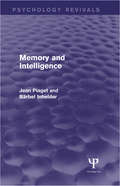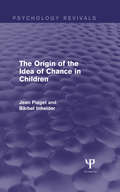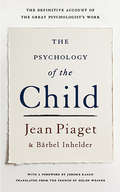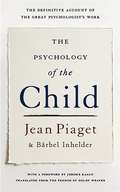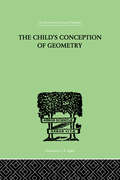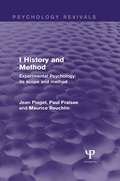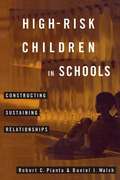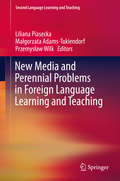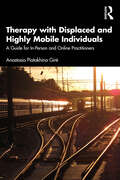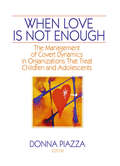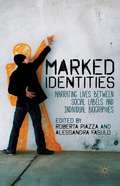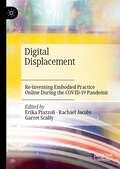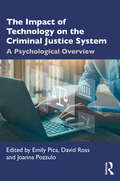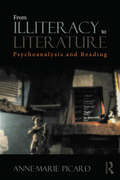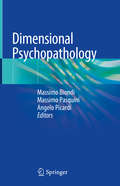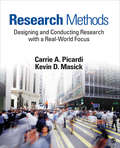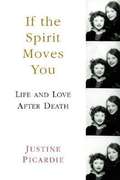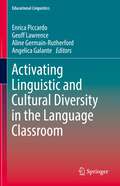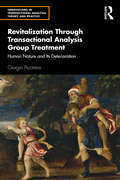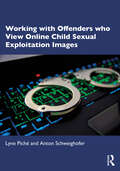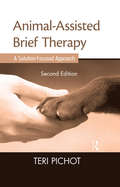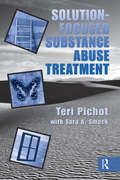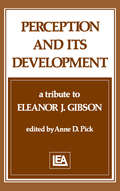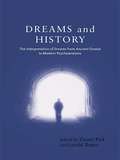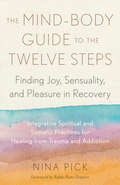- Table View
- List View
Memory and Intelligence (Psychology Revivals)
by Jean Piaget Bärbel InhelderIn the course of their researches for Mental Imagery in the Child (1971), the authors came to appreciate that action may be more conducive to the formation and conservation of images than is mere perception. This raised the problem of memory and its relation to intelligence, which they examine in this title, originally published in English in 1973. Through the analysis primarily of the child’s capacity for remembering additive and multiplicative logical structures, and his remembrance of causal and spatial structures, the authors investigate whether memories pursue their own course, regardless of the intelligence or whether, in specified conditions, mnemonic improvements may be due to progress in intelligence. They examine the relationship between the memory’s figurative aspects (from perceptive recognition to the memory-image) and its operational aspects (the schemata of the intelligence), and stress the fundamental significance of the mnemonic level known as the ‘reconstructive memory’. This was a pioneering work at the time, presenting illuminating conclusions drawn from extensive research, together with a number of constructive ideas which opened up a fresh approach to an important area of educational psychology.
The Origin of the Idea of Chance in Children (Psychology Revivals)
by Jean Piaget Barbel InhelderAlthough originally published in France in 1951 this English translation was not published until 1975. The book supplements the authors’ previous publications on the development of thought in the child and is the result of two preoccupations: how thought that is in the process of formation acts to assimilate those aspects of experience that cannot be assimilated deductively – for example, the randomly mixed; and the necessity of discovering how the mental processes work in the totality of spontaneous and experimental searchings that make up what is called the problem of ‘induction’. Induction is a sifting of our experiences to determine what depends on regularity, what on law, and what on chance. The authors examine the formation of the physical aspects of the notion of chance; they study groups of random subjects and of ‘special’ subjects; and they analyse the development of combining operations which contributes to determining the relationship between chance, probability, and the operating mechanisms of the mind.
The Psychology Of The Child: Classification And Seriation (International Library Of Psychology Ser.)
by Jean Piaget Barbel InhelderThe definite account of psychologist Jean Piaget's work Jean Piaget's influence on psychology has been profound. His pathbreaking investigations and theories of cognitive development have set child psychology moving in entirely new directions. His bold speculations have provided the inspiration for the work of others. His studies have been the subject of many books and countless articles. And, significantly, his influence has spread to other disciplines and is having an ever-growing impact on the general culture at large.Here Jean Piaget, with the assistance of his long-time collaborator Bärbel Inhelder, offers a definitive presentation of the developmental psychology he has elaborated over the last forty years. This comprehensive synthesis traces each stage of the child's cognitive development, over the entire period of childhood, from infancy to adolescence.
The Psychology of the Child
by Jean Piaget Barbel InhelderPiaget’s influence on psychology has been profound. His pathbreaking investigations and theories of cognitive development have set child psychology moving in entirely new directions. His bold speculations have provided the inspiration for the work of others. His studies have been the subject of many books and countless articles. And, significantly, his influence has spread to other disciplines and is having an ever-growing impact on the general culture at large.Here Jean Piaget, with the assistance of his long-time collaborator Bärbel Inhelder, offers a definitive presentation of the developmental psychology he has elaborated over the last forty years. This comprehensive synthesis traces each stage of the child’s cognitive development, over the entire period of childhood, from infancy to adolescence.
Child's Conception Of Geometry
by Jean Piaget Barbel Inhelder Alina SzeminskaFirst published in 1999. Routledge is an imprint of Taylor & Francis, an informa company.
Experimental Psychology Its Scope and Method: History and Method (Psychology Revivals)
by Jean Piaget Maurice Reuchlin Paul FraisseFirst published in English 1968, in this volume Paul Fraisse begins with history, looking at the evolution of experimental psychology, starting with its origins. He then moves on to the establishment of experimental psychology around the world. In the second chapter he discusses the experimental method. In the third chapter Jean Piaget tackles the questions of explanation and parallelism and their problems within experimental psychology. The final chapter by Maurice Reuchlin goes on to discuss measurement in psychology looking at various scales with their experimental conditions and numerical properties.
High-Risk Children In Schools: Constructing Sustaining Relationships
by Robert Pianta Daniel WalshHigh Risk Children in Schools offers a way for psychologists and educators to see and talk about the growing population of "at-risk" children--those likely to fail at formal schooling--while helping to redefine the relationship between schools and families. Using systems theory and developmental psychology, the authors present a new framework for the study and education of children who are at-risk. This framework--the Contextual Systems Model--creates a dialogue between the child and schooling through which meaning, goals, and experiences are shared and accepted.
New Media and Perennial Problems in Foreign Language Learning and Teaching
by Liliana Piasecka Małgorzata Adams-Tukiendorf Przemysław WilkThe book concerns the ways in which the new media shape communication along with educational expectations and practices in foreign language classrooms. Although foreign language learners have cheap and easy access to information and ways of communication, they also wrestle with problems that have always accompanied language learning. The focus of the book is two-fold. On the one hand, the authors demonstrate how using social networks, videoconferencing, mobile phones, wikis, and computer-mediated interaction contributes to the development of language skills, negotiated interaction, autonomy, and intercultural competence. On the other, they discuss "old" issues pertaining to the role of vocabulary, corrective feedback, textbooks and inner speech in the process of language learning and use. Every chapter reports original empirical research on issues related to the new media and old problems in foreign language teaching contexts in various countries, and with respect to various age groups.
Therapy with Displaced and Highly Mobile Individuals: A Guide for In-Person and Online Practitioners
by Anastasia Piatakhina GiréThis book provides therapists with an understanding of displacement-related issues to help them better serve potential clients such as emigrants, expats, migrants, digital nomads – all those who have left their original home country behind and moved to a different culture and place. With the spread of communication technologies, psychotherapists are expanding their practice to the online setting and into the unfamiliar waters of transcultural counselling with highly mobile and displaced individuals. Building on her research, the author brings up new concepts in therapy practice with emigrants, calling for a displacement-focused, transcultural approach for a modern psychotherapy practice, blended or online, in a world shaped by ubiquitous displacement. Giré’s own experience of relocations and multicultural families have helped her develop a personal approach to universal topics of the therapeutic endeavour, such as displacement, multilingualism, and shame. Meeting displaced individuals’ mental health needs is a priority for the mental health community. Therapy with Displaced and Highly Mobile Individuals will be of interest to all therapists working online with this client group, and for all those interested in psychotherapy (therapists or not), who want to learn about the psychological issues created by displacement.
When Love Is Not Enough: The Management of Covert Dynamics in Organizations That Treat Children and Adolescents
by Donna PiazzaWhen Love Is Not Enough relates how a multitude of factors--the competence of staff; the safety, nurturing, and protective elements of the emotional, physical, and political setting; and all overt and covert organizational dynamics--determine whether or not a treatment setting accomplishes its therapeutic aims. Authors in When Love Is Not Enough continue the emphasis on the group-as-a-whole “Group Relation” model of organizational and group processes begun with Wilfred Bion’s work at the Tavistok Clinic in London in the 1940s. This model helps those providing services to children and adolescents evaluate their treatment programs and make the necessary changes toward improvement.Chapters in When Love Is Not Enough are dedicated to improving the psychological treatment of children and adolescents in postmodern society, a society in which life in interdependent communities is becoming increasingly important for the health and survival of all persons. Topics covered include: the Tavistok approach to understanding group and organizational behavior the emphasis on group-as-a-whole in problem solving and treatment design narrowing the gap between plan and outcome the dynamics involved in the psychiatric treatment of children issues of staff selection, training, and development in programs designed to treat children countertransference responses in the treatment of children and adolescents revitalizing organizations the subjective experience of school lifeWhen Love Is Not Enough helps organizations realize the ways in which they may, inadvertently, undermine the emotional and cognitive functioning of the staff or the identified patients and set serious limits on the growth of members of the organization, staff and patients alike. It urges organizations to conduct an ongoing self-scrutiny concerning their rational and irrational processes, as this self-examination is crucial to the health and vitality of the treatment offered to others. The book also promotes thinking of the conscious and unconscious dynamics of the group-as-a-whole to more completely inform organizational decisions concerning changes that may enhance the treatment of children and adolescents.When Love Is Not Enough serves as an invaluable guide for mental health professionals who treat children and adolescents, group therapists, hospital and clinic administrators, psychoanalysts, nurses, social workers, psychologists, and psychiatrists.
Marked Identities
by Roberta Piazza Alessandra FasuloWestern society has become increasingly diverse, but stereotypes still persist in the public discourse. This volume explores how people who have a marked status in society - among them Travellers, teenage mothers, homeless people - manage their identity in response to these stereotypes.
Digital Displacement: Re-inventing Embodied Practice Online During the COVID-19 Pandemic
by Erika Piazzoli Rachael Jacobs Garret ScallyThis book conceptualises the novel notion of ‘digital displacement’: the sudden pivoting to online technology in education caused by the Covid-19 pandemic. The book documents this historical phenomenon in education and discusses the consequences for educator practice and educational strategies, in particular arts-based educators. Its content and scope cover both practice-based and academic frameworks, offering a scholarly investigation of the effect of the pandemic on embodied work, including drama, music, voice, dance and film, through a series of seven case stud-ies. The book also examines embodied online practice with a view to how COVID-19 has changed this in the long term.
The Impact of Technology on the Criminal Justice System: A Psychological Overview
by Emily Pica David Ross Joanna PozzuloThis comprehensive volume explores the impact of emerging technologies designed to fight crime and terrorism. It first reviews the latest advances in detecting deception, interrogation, and crime scene investigation, before then transitioning to the role of technology in collecting and evaluating evidence from lay witnesses, police body cameras, and super-recognizers. Finally it explores the role of technology in the courtroom with a particular focus social media, citizen crime sleuths, virtual court, and child witnesses. It shines light on emerging issues, such as whether new norms have been created in the emergence of new technologies and how human behaviour has shifted in response. Based on a global range of contributions, this volume provides an overview of the technological explosion in the field of law enforcement and discusses its successes and failures in fighting crime. It is valuable reading for advanced students in forensic or legal psychology and for practitioners, researchers, and scholars in law, criminal justice, and criminology.
From Illiteracy to Literature: Psychoanalysis and Reading
by Anne-Marie PicardFrom Illiteracy to Literature presents innovative material based on research with ‘non-reading’ children and re-examines the complex relationship between psychoanalysis and literature, through the lens of the psychical significance of reading: the forgotten adventure of our coming to reading. Anne-Marie Picard draws on two specific fields of interest: firstly the wish to understand the nature of literariness or the "literary effect", i.e. the pleasures (and frustrations) we derive from reading; secondly research on reading pathologies carried out at St Anne’s Hospital, Paris. The author uses clinical observations of non-reading children to answer literary questions about the reading experience, using psychoanalytic theory as a conceptual framework. The notion that reading difficulties or phobias should be seen as a symptom in the psychoanalytic sense, allows Picard to shed light on both clinical vignettes taken from children’s case histories and reading scenes from literary texts. Children experiencing difficulties in learning to read highlight the imaginary stakes of the confrontation with the arbitrary nature of the letter and the "price to pay" for one’s entrance into the Symbolic. Picard applies the lesson "taught" by these children to a series of key literary texts featuring, at their very core, this confrontation with the signifier, with the written code itself.. This book argues that there is something in literature that drives us back, again and again, to the loss we have suffered as human beings, to what we had to undergo to become human: our subjection to the common place of language. Picard shows complex Lacanian concepts "at work" in the field of reading pathologies, emphasizing close reading and a clinical attention to the "letter" of the texts, far from the "psychobiographical" attempts at psychologizing literary authors. From Illiteracy to Literature presents a novel psychodynamic approach that will be of great interest to psychotherapists and language pathologists, appealing to literary scholars and those interested in the process of reading and "literariness."
Dimensional Psychopathology
by Angelo Picardi Massimo Pasquini Massimo BiondiThis book presents an innovative approach to clinical assessment in psychiatry based on a number of psychopathological dimensions with a presumed underlying pathophysiology, that are related to fundamental phenomenological aspects and lie on a continuum from normality to pathology. It is described how the evaluation of these dimensions with a specific, validated rapid assessment instrument could easily integrate and enrich the classical diagnostic DSM-5 or ICD-10 assessment. The supplemental use of this dimensional approach can better capture the complexity underlying current categories of mental illness. The findings from a large patient sample suggest how this assessment could give a first glance at how variable and multifaceted the psychopathological components within a single diagnostic category can be, and thereby optimise diagnosis and treatment choices. Being short and easy to complete, this dimensional assessment can be done in a busy clinical setting, during an ordinary psychiatric visit, and in an acute clinical context, with limited effort by a minimally trained clinician. Therefore, it provides interesting and useful information without additional costs, and allows research work to be performed even in difficult settings.
Research Methods: Designing and Conducting Research With a Real-World Focus
by Carrie A. Picardi Kevin D. MasickResearch Methods: Designing and Conducting Research with a Real-World Focus provides the tools required to conduct relevant, high-quality research in both the classroom and the field. Carrie A. Picardi and Kevin D. Masick—psychologists with expertise in both teaching research methods and applying methods to diverse field settings—offer a unique perspective by integrating current research articles with field-specific scenarios. They draw from research methodology tactics, strategy, and constraints from practitioners across the social sciences and in business. This text effectively bridges the gap between theory and practice by demonstrating how research is done within an organizational setting, and supplies students with relevant, applicable examples to learn from.
If the Spirit Moves You: Life and Love After Death
by Justine PicardieIf the Spirit Moves You is the story of life after death--it chronicles a year in the life of Justine Picardie following the death of her sister, her soul-mate, from breast cancer. It tells of the yearning to conjure again a voice from the vast silence, of how we fill the space that appears when someone dies, or how the void fills itself, of a bond between sisters that, like an endless conversation, carries on. Told in a series of diary entries from Good Friday 2000 to Easter Sunday 2001, it is filled with significant characters from the author's life--her Jewish academic father, who searches for answers to life's existential questions in the Kabbalah; her Catholic therapist mother; her husband; her children-as well as the spiritualists she encounters and their machines that speak to the dead. If the Spirit Moves You is poignant and bracing, cosmic and uplifting, all at once.
Activating Linguistic and Cultural Diversity in the Language Classroom (Educational Linguistics #55)
by Enrica Piccardo Geoff Lawrence Aline Germain-Rutherford Angelica GalanteThis book challenges the reader to rethink and reimagine what diversity in language education means in transnational societies. Bringing together researchers and practitioners who contributed to the international LINguistic and Cultural DIversity REinvented (LINCDIRE) project, the book examines four pillars of innovation in language education: the Action-oriented approach, Plurilingualism, Indigenous epistemologies and Technology enhanced learning. The book critically discusses plurilingual pedagogical approaches that draw on learners' linguistic and cultural repertoires to encourage and support the dynamic use of languages in curricular innovation. It is a fundamental resource for language teachers, curriculum designers and educational researchers interested in understanding current thinking on the relevance and benefit of a plurilingual paradigm shift for language education in today's societies. More specifically, this book: Examines the development of plurilingualism and the potential of real-life oriented teaching and learning. Explores the concept of plurilingual and pluricultural competence. Focuses on collaboration and reflection from a humanistic tradition. Explores educational technology and explains the limitations and challenges of adopting ready-made tools. Highlights the iterative, design-based research process that informed the development of LINCDIRE’s pedagogical framework and action-oriented scenarios. Introduces practical examples of action-oriented tasks and scenarios, and illustrates the online tool (LITE) in terms of its current functionalities and design. Describes the implementation challenges and opportunities of plurilingual action-oriented tasks and discusses the results of implementation. Finally, the book examines future pedagogical innovation and research directions in order to help readers reflect on the implications of achieving sustainable change in language education.This exciting collection addresses an important question in language education: How can plurilingualism and cultural diversity be harnessed to promote sustainable innovation in language learning and teaching? Readers will find contributions from the diverse authors timely, compelling, and engaging.— Dr. Bonny Norton, FRSC, University Killam Professor, UBC Dept. of Language & Literacy Education, CanadaEmbracing a design-based research framework, this book offers learners and teachers powerful validation and a rich, relatable and inspiring action-oriented approach to holistic, dynamic, mediated, embodied, true-to-life, plurilingual language teaching and learning.— Dr. Elka Todeva, Professor of Applied Linguistics, MATESOL Program / Advanced Seminar in Plurilingual Pedagogy, SIT Graduate Institute, Washington, D.C.Anyone seeking innovation in Language Education will find in this volume a treasure trove of theoretical, empirical and methodological insights to answer the questions that arose among the 25 co-authors’ discussions to rethink language use, language learning, and language teaching.— Dr. Mercedes Bernaus, Emeritus Professor, Universitat Autònoma de Barcelona, SpainThis thought-provoking and timely book argues convincingly for the need to reconceptualize innovation in language education in an increasingly diverse world. —Dr. Regine Hampel, Associate Dean (Research Excellence), Faculty of Wellbeing, Education and Language Studies, The Open University, UK
Revitalization Through Transactional Analysis Group Treatment: Human Nature and Its Deterioration (Innovations in Transactional Analysis: Theory and Practice)
by Giorgio PiccininoThis innovative book describes the original essence particular to the human species and details the steps necessary to help re-establish this essence, in cases when it has deteriorated, in a therapeutic group context of solidarity and closeness. Disappointment in primary relationships particularly triggers the deterioration of self-offering, an initially expansive and trusting disposition to affectivity and love. People suffer when, like any fragile and delicate living being early in life, they fail to evolve according to the nature of their species. Therapeutic work is therefore described as mainly oriented to reactivate in a group, a new welcoming family, the original natural drives with new permissions, new trials and new joyful experiences. The book contains the methods and techniques routinely used by the author and two case studies, faithfully transcribed and commented on, particularly for the reactivation of the affective drive. Revitatlization Through Transactional Analysis Group Treatment is an insightful addition to the literature for transactional analysts in practice and in training, for professionals interested in the theory and practice of transactional analysis. Piccinino writes in a compelling manner allowing for the content to be accessible to anyone seeking to understand human processes and wellbeing.
Working with Offenders who View Online Child Sexual Exploitation Images
by Lyne Piché Anton SchweighoferThis comprehensive workbook addresses the use of illegal online sexual images. Focusing specifically on child sexual exploitation materials (CSEM), it offers a clear and professional manual for use with men who use CSEM. Working with clients who access illegal online images is challenging work. CSEM clients have unique characteristics and treatment needs. Designed around practitioner and client needs, each chapter provides a guide for clinicians and a subsequent set of materials for the client. The workbook covers a range of topics such as motivation for change, relationships, thinking patterns, emotions management, sexuality, computer use, Internet safety and future strategies to ensure both client and community safety. Addressing these issues as well as community accountability helps users of CSEM achieve a satisfying life while avoiding future criminal justice involvement. Through this clearly written and structured workbook, clients are given the resources to help manage problematic thoughts and/or illegal sexual behaviour. Offering evidence-based strategies rooted in the authors’ clinical experiences, the workbook enables the practitioner and client to work productively together to address the issues that have led to their involvement with illegal sexual images. This book will be helpful to a range of practitioners including forensic and clinical psychologists, as well as those working in correctional settings, such as probation and prison staff, psychiatrists, social workers, counsellors and providers of mental health treatment. It is also designed for anyone who has viewed, or is worried about viewing, sexual images of children.
Animal-Assisted Brief Therapy: A Solution-Focused Approach
by Teri PichotThis book provides an overview of Animal-Assisted Activities (AAA) and Animal-Assisted Therapy (AAT) and demonstrates how they can be incorporated into solution-focused treatment programs. Pichot, focusing on the use of therapy dogs, starts with a discussion of the basics of AAA/T and solution-focused therapy, as well as what every practitioner should know about dogs before partnering with them. Successfully combining all of this into an effective treatment program is considered next. Pichot draws upon her own experience developing an AAA/T program in the substance abuse counseling program at a county public health agency to illustrate the effective implementation of such a program and the struggles and lessons learned in doing so. Using AAA/T with special populations, cultural considerations, and the impact a therapy dog can have on the handler. New in this edition are client scenarios that demonstrate the therapist’s thought process when making clinical decisions about when and how to use a therapy dog. Sample forms and treatment plans are also provided that professionals can use to modify or structure in their work with clients. The concepts and information provided in this valuable guide will be helpful for any therapist regardless of whether he or she is in private practice or working in an agency setting.
Solution-Focused Substance Abuse Treatment
by Teri Pichot Sara A. SmockSolution-Focused Substance Abuse Treatment describes the standard of care for substance abuse treatment, demonstrates how solution-focused brief therapy exceeds this standard, and shows how it can effectively be used in substance abuse evaluation, case management, and both individual and group treatment. Beginning and advanced concepts are provided to address the questions of even the most advanced clinician, all placed in the context of cultural awareness. Most importantly, the author answers the many questions professionals may have about how solution-focused brief therapy can be successfully integrated into the field of substance abuse. It provides a thorough understanding of the issues that therapists face when working with this at times challenging population, and demonstrates how the use of solution-focused brief therapy can minimize power struggles and enhance client success. Sample forms and handouts are included, as are additional resources for effective evaluation and treatment.
Perception and Its Development: A Tribute To Eleanor J. Gibson
by Anne D. PickWe have acquired important new knowledge about the nature and development of perception in recent years, and the insights of Eleanor Jack Gibson have had a prominent role in guiding the search for that knowledge. The purpose of this volume is to honor her continuing conrbution to our understanding of perception. First published in 1979. Routledge is an imprint of Taylor & Francis, an informa company.
Dreams and History: The Interpretation of Dreams from Ancient Greece to Modern Psychoanalysis
by Daniel Pick Lyndal RoperWhat is a dream?Dreams are universal, but their perceived significance and conceptual framework change over time. This book provides new perspectives on the history of dreams and dream interpretation in western culture and thought. Dreams and History contains important new scholarship on Freud's Interpretation of Dreams (1900) and subsequent psychoanalytical approaches from distinguished historians, psychoanalysts, historians of science and anthropologists. This collection celebrates and evaluates Freud's landmark intellectual production, whilst placing it in historical context. A modern view of psychoanalysis, it also discusses the controversial idea of the role of the external world on the shaping of unconscious mental contents.In highly accessible language it proceeds through a series of richly illustrated case studies, providing new source materials and debates about the causes, meanings and consequences of dreams, past and present: from Victorian anthropological exploration of ancient Greek dream sources to peasant interpretation of dream-life in communist Russia; from concepts of the dream in sixteenth-century England to visual images in nineteenth-century symbolist painting in France. Dreams and History will fascinate those interested not only in psychoanalysis and history, but also arts, culture, humanities and literature.
The Mind-Body Guide to the Twelve Steps: Finding Joy, Sensuality, and Pleasure in Recovery--Integrative spiritual and somatic practices for healing from trauma and addiction
by Nina PickA trauma-sensitive companion to the Twelve Steps: body-based exercises for deepening your recovery, expanding your spiritual practice, preventing relapse, and understanding the root of your addiction. For readers of In the Realm of Hungry Ghosts and Trauma and the 12 StepsConsidering addiction through a trauma-informed lens, The Mind-Body Guide to the Twelve Steps offers an accessible, lyrical, and practical guide to Twelve Step recovery that emphasizes self-compassion, relationship, embodied awareness, and ecological connection.Whether you're suffering from an active addiction, seeking freedom from self-limiting behaviors, or hoping to establish or grow your spiritual practice, this innovative guide offers a holistic roadmap to navigating the journey of recovery.Somatic and spiritual counselor, educator, and writer Nina Pick shows how addiction is rooted in survival strategies that protect us from overwhelmingly painful experiences.Pick draws on attachment theory, polyvagal theory, somatics, mindfulness, trauma therapy, Jewish and integrative spirituality, and her own long-time experience in recovery to expand the Twelve Step practice beyond the conventional cognitive approach into one of &“soul recovery&”—a profound and sensuously embodied spiritual path.With reflections and practices designed to complement the literature and tools offered by your specific Twelve Step program, The Mind-Body Guide to the Twelve Steps shows you how to:Explore powerlessness and unmanageabilityIntegrate dance, vocalization, and other creative arts to enhance your recoveryCreate transformative ritual and ancestral healing practicesExpand your ideas of Higher Power and prayerForgive yourself and others Cultivate daily practices for reflection and meditationUnderstand the intersections of addiction, developmental trauma, and intergenerational traumaDrawing on plant medicine, mindfulness, poetry, self-directed touch, ritual, and guided imagery, The Mind-Body Guide to the Twelve Steps nurtures a joyful and heart-centered path to recovery and complements the healing work of Peter Levine, Bessel van der Kolk, and Arielle Schwartz.
